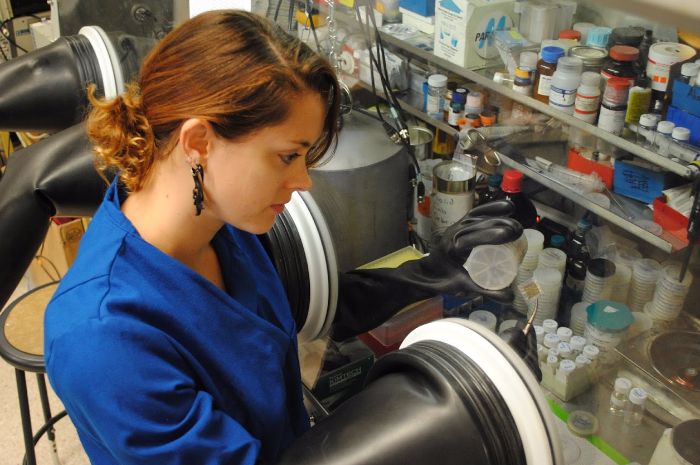Katie Hellier sits outside the National Renewable Energy Lab in Golden, Colorado, answering the question about why she loves physics by talking about shoes.
A stiletto heel will exert great pressure on the ground while a flat shoe will apply much less, and physics can illuminate why that is, says the UC Santa Cruz grad student. Thanks to a U.S. Energy Department grant, Hellier is doing research into new solar cell materials that may one day be able to generate high-voltage energy instead of the low voltage delivered now.
“The beauty of physics is the logic that goes into explaining how things work,” Hellier says.
That the 30-year-old daughter of a tech-savvy chemist and assistant school superintendent with a degree in accounting would turn to talk of footwear when explaining why she loves science is not as surprising as it may seem.
Hellier not only has a degree from the Fashion Institute of Design and Merchandising in San Francisco and once created a clothing line around the music of Death Cab for Cutie but is also a regular at Burning Man with her own art offering, and once was part of a theater troupe that did parodies of horror movies on stage.
“In high school, I either wanted to get a degree in math or a degree in costume design,” she says. “I also thought about becoming a criminal lawyer.”
The road to the lab where Hellier now works actually began with the 2008 recession after she’d graduated from design school. There were few fashion jobs to be had, and so Hellier took a full-time, salaried job managing a Marie Callender’s restaurant.
Already a self-starter, she’d started working for the chain at age 16, gradually taking on more decision-making responsibilities until, by 18, she was one of the youngest upcoming managers in what was then a huge chain.
But customer service and 80-hour weeks wore her out, and eventually she decided to return to school. It was at Los Medanos College in Pittsburg, Calif., that she took her first physics class and, as she says it, “fell in love.”
Transferring to UC Santa Cruz in 2011, she was at an informal Women in Physics dinner when she met Professor of Physics Sue Carter. Hellier didn’t know much about solar-cell research, but as she listened to Carter speak about the technology, she decided that’s what she wanted to do with her life. She asked Carter for a spot in her lab and eventually worked on projects that ranged from using algae for biofuels to researching luminescent solar concentrators, which use fluorescent dye to absorb light and make solar cells more efficient. Part of that research became the foundation for a company that provides solar panels that make agricultural greenhouses more cost-effective to use.
But working in a research lab as an undergraduate wasn’t always easy, says Hellier, which is where the lessons in self-starting she learned at Marie Callender’s came in handy. There was no handholding and not a lot of time for instruction, she says.
“I had to step up and figure out how to do things on my own.”
“As an undergrad, Katie was already acting like a grad student or a postdoc,” says UC Santa Cruz Associate Professor of Particle Physics Tesla Jeltema. “She was running her own projects and training other students.”
Eventually, Hellier became lab manager, where she helped supervise a total of 15 undergrad students over the years.
While at UC Santa Cruz, Hellier also was instrumental in developing the Women in Physics and Astronomy group on campus. According to Jeltema, Hellier helped turn the organization into a more formal group with regular meetings, developed a website for the organization, and, in 2015, helped host a national conference for undergraduate women in physics on campus. She also was president of the organization for several years.
With a $3,000-a-month Department of Energy grant in hand, Hellier is now in Colorado testing a new solar-cell material that might be able to generate the high voltages needed for industry — something that isn’t feasible now.
Sitting on a bench with a view of a babbling creek and distant Rockies, Hellier says she is not only excited about the possibilities of the research she is doing but also about eventually becoming a professor and a mentor to students.
“It’s important to me to help (students) learn what research is about and to allow them to feel that sense of accomplishment, that sense of having achieved something,” she says.
As for her, not only does science allow her to do good in the world, she says, but it also does good for her, too.
“Before I started work in science, I was largely ruled by my feelings and emotions. I was a little bit more on the whimsical side, kind of dreaming about things and how things could be,” she says. “Physics brought a balance, in that I can focus on an area based on fact.
“It centers me.”



